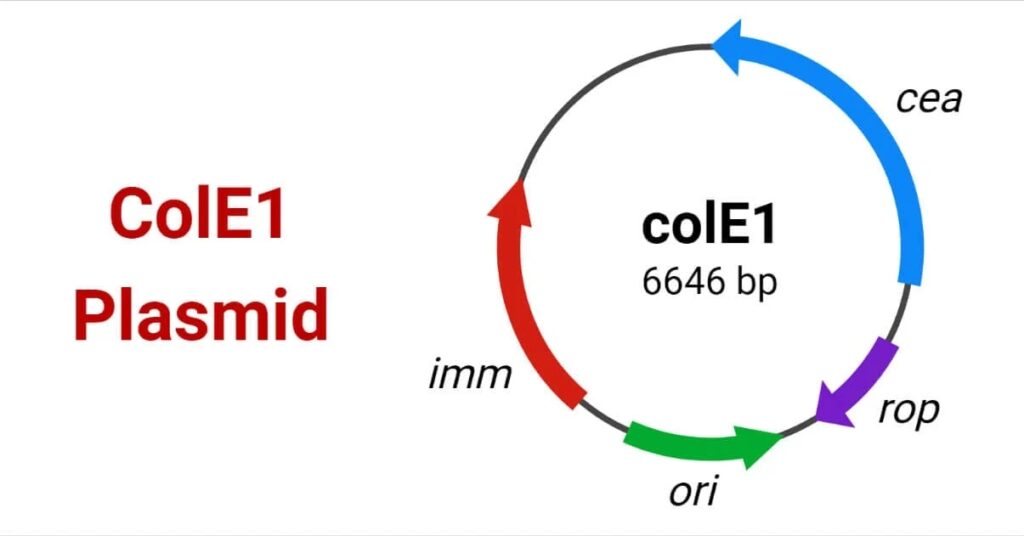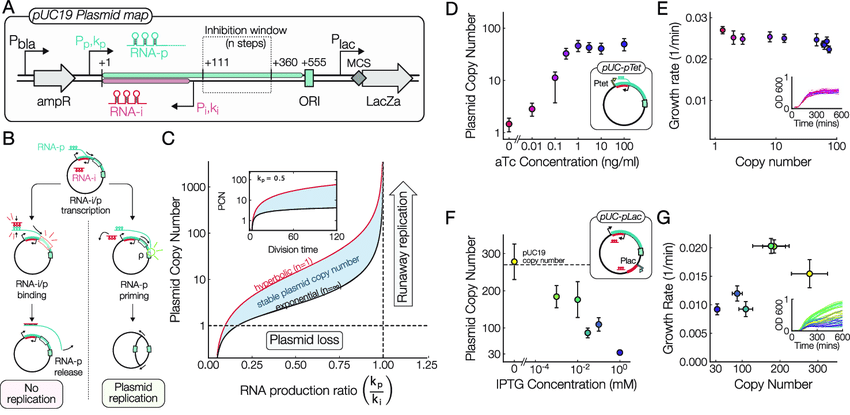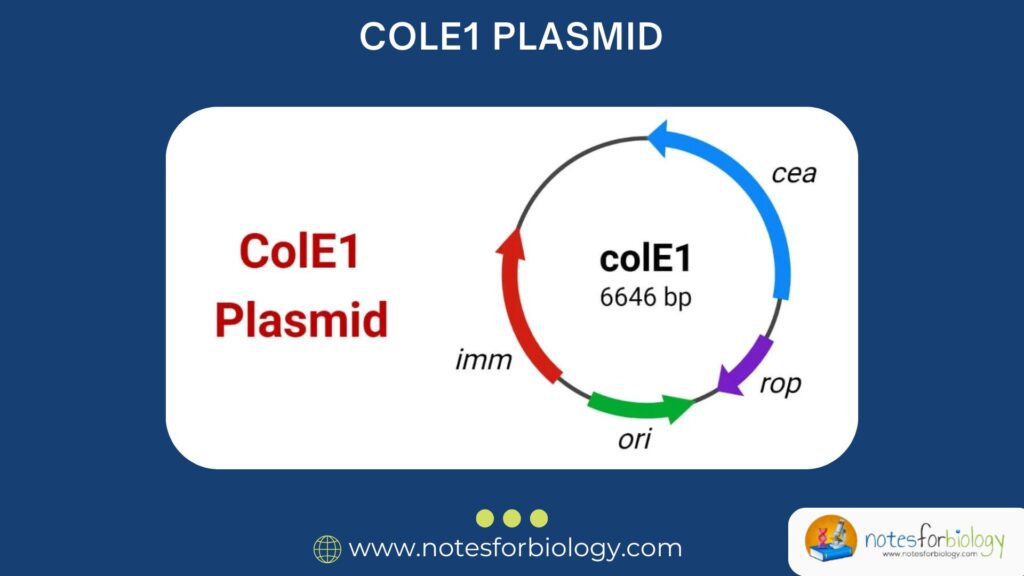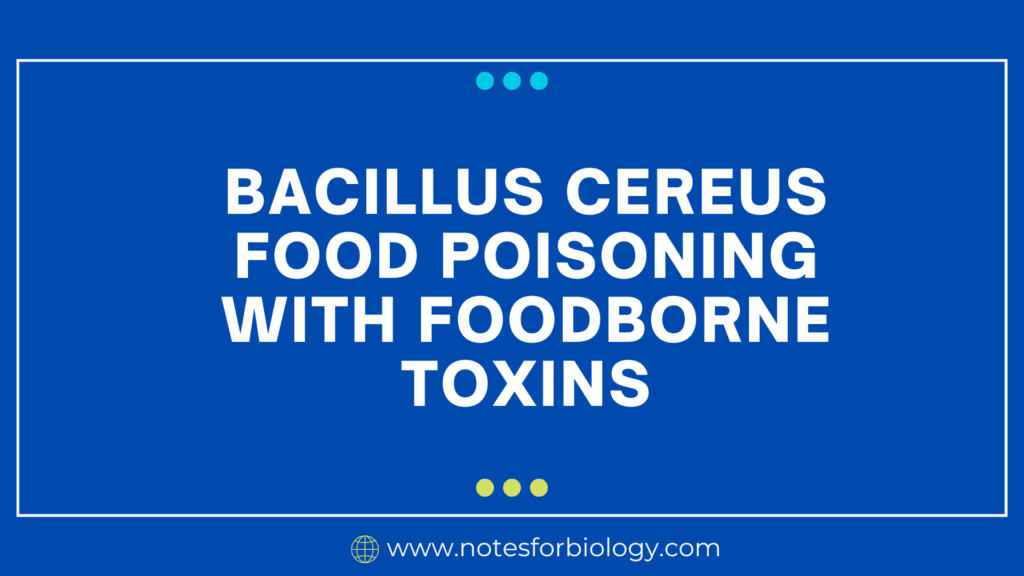Introduction
The ColE1 plasmid is a naturally occurring circular DNA molecule found in Escherichia coli (E. coli). It carries the gene for colicin E1, a toxin that kills competing bacteria, and it can replicate independently of the bacterial chromosome.
In the field of genetic engineering and biotechnology, plasmids play a central role. They are tiny, circular pieces of DNA that exist outside the chromosomes in bacteria and are used as tools to carry and insert genes in the lab. One of the most studied and widely used plasmids in molecular biology is the ColE1 plasmid.
ColE1 is much more than just a DNA circle floating inside a bacterial cell—it’s the foundation for many cloning vectors, including the famous pBR322 and pUC plasmids. But what makes ColE1 so special? How is it structured? What genes does it carry? And how does it serve scientists around the world?
This article provides a comprehensive overview of the ColE1 plasmid—its definition, structure, genetic elements (sites), and applications—in a friendly, easy-to-understand way.
Table of Contents
What is a Plasmid? (A Quick Recap)
Before diving into ColE1, let’s first understand what a plasmid is.

- A plasmid is a small, circular piece of double-stranded DNA found naturally in bacteria.
- It is separate from the bacterial chromosome and can replicate on its own.
- Plasmids often carry genes that give bacteria extra powers—like antibiotic resistance, toxin production, or fertility.
- In biotechnology, plasmids are used as vectors to carry foreign genes into a host cell (like E. coli).
What is ColE1 Plasmid?

The ColE1 plasmid is a natural plasmid originally discovered in Escherichia coli (E. coli). The name “ColE1” comes from:
- Col: It carries the colicin E1 gene, a gene that allows the bacterium to produce a toxin called colicin E1.
- E1: Refers to the specific type of colicin (E1 type).
Definition:
The ColE1 plasmid is a small, circular, extrachromosomal DNA molecule found in E. coli, known for its ability to replicate independently, carry the colicin E1 gene, and serve as a basis for cloning vectors used in genetic engineering.
Key Characteristics of ColE1 Plasmid
| Feature | Details |
|---|---|
| Type | Natural plasmid |
| Origin | E. coli |
| Size | ~6.6 kilobases (kb) |
| Shape | Circular, double-stranded DNA |
| Replication | Independent (autonomously replicating) |
| Function in nature | Produces colicin E1 (a bacterial toxin) |
| Use in labs | Backbone for cloning vectors |
Structure of ColE1 Plasmid

The ColE1 plasmid is like a toolbox with specific components that each serve a function. Here are the main structural and functional elements of ColE1:
1. Origin of Replication (ori or oriV)
- The origin of replication is the place where DNA replication begins.
- In ColE1, the ColE1-type origin is well studied and used in many artificial plasmids (like pUC and pBR322).
- It allows the plasmid to replicate independently of the bacterial chromosome.
- RNA II (a transcript of DNA) acts as a primer to initiate replication.
2. RNA I and Rom (Regulation of Replication)
- RNA I: A small RNA molecule that binds to RNA II and prevents replication when needed—helps in copy number control.
- Rom protein (also called Rop): Enhances the binding of RNA I and RNA II, providing tighter regulation.
Result: The plasmid doesn’t over-replicate and burden the host cell.
3. Colicin E1 Gene (cea)
- Codes for colicin E1, a toxin that can kill other E. coli strains that lack the ColE1 plasmid.
- Helps the host bacterium outcompete others in the same environment.
4. Immunity Gene (imm or cei)
- Protects the host bacterium from being killed by its own colicin.
- Ensures self-resistance.
5. Lysis Gene (kil)
6. Mobility (Mob) and Transfer (tra) Sites
- Mob site: Helps plasmid get transferred during bacterial conjugation (horizontal gene transfer).
- tra genes: Not present in ColE1 itself, but when supplied by other plasmids, allow transfer.
Summary of Genetic Sites in ColE1 Plasmid
| Site / Gene | Function |
|---|---|
| ori | Origin of replication |
| RNA II | Primer for DNA synthesis |
| RNA I | Inhibits replication (copy control) |
| Rom (Rop) | Stabilizes RNA I–RNA II complex |
| cea (colicin E1) | Toxin production |
| cei (immunity) | Protects from colicin |
| kil | Lysis gene to release colicin |
| mob | Mobilization site |
Applications of ColE1 Plasmid
The natural ColE1 plasmid laid the groundwork for a whole family of cloning vectors used in molecular biology.
1. Basis for Cloning Vectors
- Plasmids like pBR322, pUC18, and pUC19 are engineered from ColE1.
- Scientists modify the natural plasmid by:
- Removing toxin genes (like colicin)
- Adding multiple cloning sites (MCS)
- Inserting antibiotic resistance markers
- Including promoters for gene expression
2. Gene Cloning and Expression
- Cloning foreign DNA: Scientists can insert genes into ColE1-derived plasmids to make bacteria produce proteins (e.g., insulin).
- The ColE1 origin ensures high copy numbers, making it efficient for DNA production.
3. Production of Biopharmaceuticals
- Genetically engineered bacteria carrying ColE1-based plasmids can produce:
- Insulin
- Growth hormones
- Vaccines
- Enzymes
4. Synthetic Biology
- Used in modular design of genetic circuits
- Building synthetic organisms with predictable behaviors
5. Molecular Studies
- Used to study:
- Gene regulation
- Promoter activity
- Mutagenesis
- RNA interference
6. Antibiotic Resistance Studies
- Scientists use ColE1-based vectors to study resistance mechanisms by inserting various resistance genes into them.
7. Horizontal Gene Transfer Studies
- ColE1’s ability to move between bacteria (when paired with conjugative plasmids) helps in studying bacterial evolution and gene spread.
Advantages of ColE1-Based Plasmids
High Copy Number – More DNA for experiments
Well Studied and Reliable – Standard in molecular labs
Easily Modifiable – Can insert multiple genetic elements
Compatible with E. coli – Most common lab bacteria
Efficient Replication – Rapid multiplication
Limitations
Natural ColE1 carries toxin genes – Must be removed before lab use
Limited to certain bacterial species
Copy number control can vary depending on RNA I/Rom function
Not suitable for large DNA inserts – Smaller size capacity
Real-Life Examples
pBR322 – Derived from ColE1
- One of the first artificial plasmids
- Contains:
- Ampicillin and tetracycline resistance genes
- ColE1 origin of replication
pUC18 and pUC19
- Modified to include blue-white screening
- Very high copy number plasmids
Conclusion
The ColE1 plasmid may be small, but it is one of the most powerful tools in molecular biology. From its natural role in helping E. coli compete using colicin to its adapted role in gene cloning, expression, and biotechnology, ColE1 has changed the way we do science.
Its clean design, reliable replication, and modifiable nature make it the backbone of genetic engineering. Understanding ColE1 isn’t just about memorizing gene names—it’s about appreciating a tool that has helped produce insulin, discover genes, and build new frontiers in synthetic biology.
FREQUENTLY ASKED QUESTIONS
What is the ColE1 plasmid?
The ColE1 plasmid is a naturally occurring circular DNA molecule found in Escherichia coli (E. coli). It carries the gene for colicin E1, a toxin that kills competing bacteria, and it can replicate independently of the bacterial chromosome.
Why is it called ColE1?
Col = Colicin (a toxin)
E1 = The specific type of colicin (E1)
So, ColE1 refers to a plasmid that produces colicin E1 in E. coli.
What is the size of the ColE1 plasmid?
The natural ColE1 plasmid is about 6.6 kilobases (kb) in length.
Related Articles




